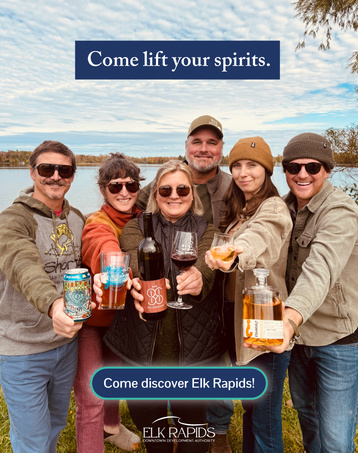
Roundabout Coming To Blair Townhall Road, Six More To Follow Across GT County
By Beth Milligan | Dec. 5, 2019
A new roundabout will be constructed at the intersection of Blair Townhall Road and M-37 in 2021, the Michigan Department of Transportation (MDOT) announced Wednesday – one of seven roundabout projects planned in the coming years across Grand Traverse County.
MDOT was already planning to widen M-37 between Vance Road and Blair Townhall Road to add a center left-turn lane in 2021. But after evaluating crash data for the Blair Townhall Road/M-37 intersection, MDOT expanded the project scope to include a roundabout at the site, the department said Wednesday. The intersection – which currently has a blinking light and serves as the entrance to the popular Northwestern Michigan Fair Grounds – has been the frequent site of high-speed crashes, including 28 accidents in the last five years. Those included eight injury-causing crashes and one fatal collision. The most common type of accidents have been rear-end crashes, closely followed by angle crashes (one driver turning in front of another).
“It’s a dangerous intersection, and the crashes that happen there are generally serious because of the speed of vehicles traveling down the highway,” says Blair Township Supervisor Nicole Blonshine. “There are two residential areas on either side pulling out onto the highway. We’re seeing increased traffic volumes, and impatient drivers also play a role, when you have people stopping on the highway to make a right or left turn. So we have a lot of accidents and congestion, especially during fair week.”
Blonshine says that while the intersection is in desperate need of safety upgrades, she was initially skeptical of MDOT’s plan to install a roundabout instead of a signal. “My initial thought was, ‘Why don’t we get a traffic light?’” she says. “I truly thought traffic lights were the best way to go. But I was not educated. Statistically, roundabouts are much safer – there’s a slower rate of speed, and the impacts are not as significant. It’s also proven to be more effective with the flow of traffic, versus the stop-and-go of a traffic signal. I really believe that traffic in that area needs to slow down, but also keep moving.”
Blonshine’s observations are backed by state and federal traffic data, which state that roundabouts reduce fatal collisions by 90 percent, injury collisions by 75 percent, and overall collisions by 37 percent, according to the Federal Highway Administration and Insurance Institute for Highway Safety. While a typical four-way signaled intersection has 32 conflict points, a roundabout has eight. The continuous flow of traffic at a roundabout versus a signal intersection reduces vehicle stops by 56 percent and delays by 20 percent, according to the Insurance Institute for Highway Safety. Roundabouts also have cheaper maintenance costs, saving an estimated $5,000-$10,000 in expenses related to hardware and electrical costs for traffic signals.
Despite that data, roundabouts have often met with resistance from drivers, including in northern Michigan. The state’s first roundabout wasn’t constructed until 1996, and early iterations “were not built well…and really set people off on the wrong path,” says Grand Traverse County Road Commission Manager Brad Kluczynski. He notes that roundabouts have significantly improved since then – and tend to be better received by drivers the more they get used to them. In Grand Traverse County, three roundabouts were built on M-72 and Lautner Road in Williamsburg in 2015, followed by a roundabout constructed this year at the intersection of US-131, M-186, and West State Street in Fife Lake.
“If you look at M-72 in front of Meijer, it’s great,” says Kluczynski. “You never have a stoppage. You have to slow down to go through them, but you’re never stopped at a stop light. You will still have some accidents with a roundabout, but they’re property damage. It’s a fender-bender. You’re not getting t-bones or head-ons.”
The Road Commission is counting on drivers becoming familiarized with roundabouts – the agency has plans to construct six starting in 2021. The first (and least expensive) is slated for the intersection of Hammond and Four Mile Road, at an estimated project cost of $800,000. “It’s a smaller roundabout, and it’s our first one, so we want to make sure we get everything right,” says Kluczynski. From there, the Road Commission plans to build two more roundabouts on Hammond – at Garfield Road and Three Mile (estimated cost of $2.5 million each) – and two on Keystone Road, at the intersections of Cass Road ($1.7 million) and River Road ($1.25 million).
“We’re planning on continuing on (after Hammond/Four Mile in 2021) and building one or two roundabouts each year until our last one is done, which would be in 2024,” says Kluczynski. Final project costs will be contingent on engineering design and right-of-way acquisition expenses, among other factors. The five planned roundabouts are the result of the Road Commission’s recently completed East-West Corridor Study, which evaluated potential projects to improve east-west traffic flow in the Grand Traverse region. The sixth and final roundabout – which is unconnected to the East-West Corridor Study – is a safety upgrade to the intersection of Garfield and Potter roads. That roundabout project could take place as soon as 2021, depending on approval of safety grant funds the Road Commission plans to apply for in 2020.
To help drivers acclimate to the planned increase in roundabouts, MDOT and Blair Township will hold public input sessions in 2020 to answer questions on the Blair Townhall Road/M-37 project and provide education on navigating the intersection. MDOT also has instructional videos and tip sheets for using roundabouts (key takeaways include choosing your lane before entering the roundabout, yielding to traffic already in the roundabout, yielding to pedestrians in crosswalks, and indicating your exit with your turn signal). Kluczynski believes drivers will become less resistant to roundabouts the more they encounter them and experience their convenience and safety benefits. “I think a lot of it goes to education and just getting people familiar with them,” he says.
Comment






